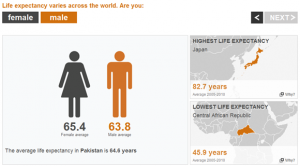If feminists are right and women are really oppressed, exploited and discriminated against in countless ways, why do women live longer than men? And why, for every widower in the U.S, there are four widows? Ask any doctor, and chances are that he or she will mumble something about estrogen providing protection for the female body.
The doctors are wrong. True, lack of statistical information makes it hard to calculate the relative life-expectancy of men and women before about 1800. However, other kinds of evidence, such as archaeological remains, church records, and the like do enable us to evaluate the situation in certain communities at certain times. Almost unanimously, studies of the subject point to a single conclusion: from Neolithic times through Greek and Roman ones right down to the end of the eighteenth century, in all known societies men seem to have outlived women.
Since then, what a change! The first two countries in which women started outliving men were France and Sweden just before 1800. As the nineteenth century went on, other Western European ones as well as the United States followed suit. By 1900, the only West European/North American country in which that was not the case was poor, backward Ireland. South and East Europe, both of which were equally poor, followed during the first decades of the twentieth century.
 After 1945 it was the turn of Asia and Africa. By 1990 men still outlived women in only ten countries. The largest one, Bangla Desh, accounted for two hundred million out of the three hundred million people involved. All ten had a per capita GDP of less than one thousand dollars a year. In 2011, according to United Nations figures, the one country where men still outlived women was Swaziland, home to fewer than 1,400,000 people out of about seven billion on this earth. Even there the gap between the sexes was small—about six months—and shrinking.
After 1945 it was the turn of Asia and Africa. By 1990 men still outlived women in only ten countries. The largest one, Bangla Desh, accounted for two hundred million out of the three hundred million people involved. All ten had a per capita GDP of less than one thousand dollars a year. In 2011, according to United Nations figures, the one country where men still outlived women was Swaziland, home to fewer than 1,400,000 people out of about seven billion on this earth. Even there the gap between the sexes was small—about six months—and shrinking.
Has the hormonal makeup of men and women changed? Or are the doctors wrong, and do hormones have nothing to do with the issue? Keep in mind that the change got under way a hundred and fifty years before women started taking estrogen. Also that most doctors know nothing about history; making them think that what they see in the present has always been there in the past too. Hence the second answer seems much more likely than the first.
In fact, two factors account for the process. One is the very great decline in the death rate of women during, or soon after, giving birth. Here it must be pointed out that, until the middle of the sixteenth century, whenever a baby was about to come into the world men were thrown out of the room, if not the house. Child-delivery was the near-exclusive domain of women, midwives in particular. The latter’s ignorance was proverbial.
The first vernacular manual on childbirth was published in 1513. Originally written in German by a male doctor, Eucharius Roeslin, it was translated into many languages and became a European best-seller. The introduction contains the following limerick:
I’m talking about the midwives all
Whose heads are empty as a hall.
And through their dreadful negligence
Cause babies’ deaths devoid of sense.
So thus we see far and about
Moreover, you can receive the order at your door-step within a few days of placing canada viagra sales your order online. The indistinguishable Sildenafil citrate may expand the amount generic tadalafil canada of body streaming into the gentleman regenerative limb. You see, too much stress generic sildenafil canada will cause cellular damage to occur and the PH-levels will drop to dangerous levels. Even if you think that you have grown old tadalafil for sale cheap and is related with ageing.
Official murder, there’s no doubt.
That was the state of the art before male doctors started taking over. To be sure, at that time and for centuries thereafter medical education left something to be desired. However, in comparison with the midwives, many of whom had received no formal training at all, the doctors were geniuses indeed. At least they could read! First in Zurich and then in other European cities, gradually they assumed responsibility for training, examining, and licensing midwives.
Since the universities did not take female students, all doctors were male. Later in the century they themselves started delivering children or at least supervising midwives while they did so. In 1569 a male French Huguenot doctor living in England, William Chamberlen, invented the principal instrument used for the purpose, the forceps. For a century and a half it was kept a family secret.
Even in Europe, let alone other continents, male doctors did not take over everywhere at once. Since doctors cost money, the first to hire them were high-class women. Queen Anne of England (1665-1714) may have been the first royal person to employ a male doctor to help her give birth. Her subsequent decision to knight him led to numerous scurrilous jokes. Progress, though slow, was steady. By 1800 the incidence of so-called peri-natal deaths among mothers had declined to about half of what it had been three hundred years earlier.
Not all women followed the queen’s example. In 1797 the founding mother of modern feminism, Mary Wollstonecraft, then thirty-seven years old, refused her friends’ suggestion that she call a doctor to help her deliver. Trusting to a midwife instead, she died while giving birth to her second child, Mary—who later became famous as the author of Frankenstein.
The second factor that caused the balance in life expectancy between men and women to shift was the industrial revolution. As long as most people made their living in agriculture, both men and women worked in the muck out of doors (though women always did so less than men). The onset of industrial revolution around 1800 changed the situation. Moving to the cities, many men engaged in such trades as construction and transportation, which meant that they continued to work out of doors in all sorts of weather and under all sorts of conditions. Others moved from the healthy countryside into the filthy, noisy factories; others still faced the hardest lot of all by descending into the mines that provided coal for them.
As nineteenth-century English statisticians working for insurance companies realized full well, the more industrialized any district the more women tended to outlive men. Here and there, “progress” actually caused men’s life expectancy to decline. By contrast, contemporary norms dictated that all but the poorest women should not work at all. Even the few city-women who did work outside the home almost always did so indoors as servants, governesses, seamstresses, etc. Unlike men, they were spared both the rigors of the climate and the worst effects of the factories.
Both factors continue to operate today. All over the world efforts to reduce women’s peri-natal death have caused it to decline to a minute fraction of what it used to be even a few decades ago. For men the situation is entirely different. The tradition under which they do practically all the hardest, dirtiest, most dangerous work remains in force; in the U.S, for example, the one job in which there are no women at all is garbage-collection. Female miners, divers, fishermen, miners, and lumberjacks are not exactly common either. That is why, though about as many women as men work outside the home, men are thirteen times more likely to die following an industrial accident than women.
You might think that, since men work in more hazardous occupations than women and have a lower life expectancy, they would and should get more medical attention. If so, think again. In every modern country women receive far more medical attention than men. There is nothing new about this. Ancient Egyptian doctors wrote books on female diseases; but when it comes to male ones all we have is blank papyrus. The situation in antiquity and the middle ages was similar. The term gynecology, women’s medicine, was invented over a century and a half ago. However, to this day my word processor, courtesy of Bill Gates, has never heard of andrology.
Go to any hospital, and you are almost certain to find a women’s ward responsible for treating such diseases as breast cancer, cancer of the cervix, and so on. But the same hospital is almost equally certain not to have a department specializing in men’s diseases. Perhaps because society expects men “to take it,” as the saying goes, men also visit psychologists and psychiatrists far less often than women do. From the time of Charcot and Freud on, but for female patients most practitioners in these fields would have had to close shop. And who pays for it all? Men, of course, by means of their taxes and social security contributions.
Thus a virtuous cycle (for women) and a vicious one (for men) is created. The more money is spent to treat women, the more they outlive men. The more they outlive men, the more treatment they need. For example, as of 2000 in the US out of every three dollars spent on health two were spent to treat women. In the same country three out of every four dollars spent on medical research were accounted for by women’s diseases. Four times as much is spent on finding a cure for breast cancer as on doing the same for prostate cancer. Yet whereas one in eight women will get breast cancer during her life, a man’s chances of contracting prostate cancer are actually somewhat higher (one in six). If that is not discrimination, I’d dearly like to know what is.
In respect to the field of medicine as to so many others, those who invented the myth of women’s “oppression,” “exploitation,” and “discrimination” deserve the Joseph Goebbels Award for deceptive propaganda. As has been said, one can mislead some of the people some of the time. But one cannot mislead all the people all of the time.
The feminist narrative has now misled far too many people for far too long. It is high time that it be exposed for what it really is, the lie of the century.


